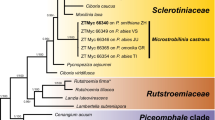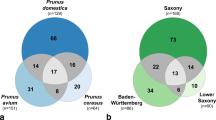Abstract
The relative frequency of Therrya fuckelii and T. pini fruiting on dead branches of Scots pine was investigated in southern Norway by examining lightning-damaged and wind-fallen trees, randomly collected branches and Nordic herbarium collections of these ascomycetes representing the order Rhytismatales. Ascus, ascospore, and subhymenium characteristics were used as criteria for species identification, while a sequence analysis of ITS rDNA gene cluster was performed to compare the relatedness of the species to each other and to corresponding fungal sequences available at the NCBI GenBank Sequence Database. In a few cases, the two Therrya species co-occurred on the same branch, but in general, whether field or herbarium material, T. fuckelii was clearly more common than T. pini. Within the Nordic countries, both species occurred throughout the natural distribution area of Scots pine. The ITS rDNA sequence of T. pini strains was 91% similar to T. fuckelii strains, the differences locating both within the internal transcribed spacers ITS1 and ITS2 and the 5.8 S rDNA gene. More variation in the ITS1-5.8S-ITS2 sequence was observed among T. pini than T. fuckelii samples; genetic implications of this finding are discussed. Upon sequence analysis, we discovered that a T. pini sequence has been deposited in the NCBI GenBank under a false identity. We emphasize the importance of co-examining strains that originate from mature fruit bodies with fully developed morphologic features as reference samples.


Similar content being viewed by others
References
Barklund P, Kowalski T (1996) Endophytic fungi in branches of Norway spruce with particular reference to Tryblidiopsis pinastri. Can J Bot 74:673–678
Botella L, Diez JJ (2011) Phylogenic diversity of fungal endophytes in Spanish stands of Pinus halepensis. Fungal Divers 47:9–18
Gardes M, Bruns TD (1993) ITS primers with enhanced specificity for basidiomycetes – application to the identification of mycorrhizae and rusts. Mol Ecol 2:113–118
Gremmen J (1955) New and noteworthy discomycetous fungi on coniferous hosts from Switzerland. Sydowia 9(1–6):432–437
Gremmen J (1960) Conifer inhabitating fungi, I: Therrya Penz. Et Sacc., Phacidium lacerum Fr. and Pseudophacidium ledi (A. Et S.) Karst. Nova Hedwigia 2(4):547–553
Karsten PA (1871) Mycologia Fennica. Pars Prima. Discomycetes. Bidrag till kännedom af Finnlands natur och folk. Finska Litteratur-Sällskapets trykeri. Helsingfors
Kujala V (1950) Über die Kleinpilze der Koniferen in Finnland. Ascomycetes, Fungi Imperfecti, Uredinales. Comm Inst For Fenn 38(4):1–121
Lantz H, Johnston PR, Park D, Minter DW (2011) Molecular phylogeny reveals a core clade of Rhytismatales. Mycologia 103:57–74
Minter DW (1996a) IMI Descriptions of fungi and bacteria. No. 1297. Therrya fuckelii. Mycopathologia 136:171–173
Minter DW (1996b) IMI Descriptions of fungi and bacteria. No. 1298. Therrya pini. Mycopathologia 136:175–177
Ortiz-Garcia S, Gernandt DS, Stone JK, Johnston PR, Chapela IH, Salas-Lizana R, Alvarez-Buylla ER (2003) Phylogenetics of Lophodermium from pine. Mycologia 95:846–859
Reid J, Cain RF (1961) The genus Therrya. Can J Bot 39:1117–1129
Solberg S, Venn K, Solheim H, Horntvedt R, Austarå Ø, Aamlid D (1994) Cases of forest damage in Norway 1992 and 1993. (In Norwegian with English summary). Rapp Skogforsk 24/94:1–35
Wang Y, Guo LD, Hyde KD (2005) Taxonomic placement of sterile morphotypes of endophytic fungi from Pinus tabulaeformis (Pinaceae) in northeast China based on rDNA sequences. Fungal Divers 20:235–260
Acknowledgements
The work was a MSc thesis at the Norwegian University of Life Sciences. Financial contribution has been given by The Norwegian forest and landscape institute. Thanks to curators at the following herbaria: The Swedish Museum of Natural History; Museum Botanicum Universitatis Helsinki; Uppsala University, Museum of Evolution; Botanical Museum Universitatis Osloensis; Botanical Museum and Library, University of Copenhagen; Turku University Herbarium; Herbarium Mycologicum, Instituti Forestalis Fenniae; Herbarium Universitatis Ouluensis; IMI Herbarium; Kuopio Natural History Museum. We thank Henrik Lantz, Uppsala University, for sharing his unpublished ITS sequence of Therrya fuckelii with us.
Author information
Authors and Affiliations
Corresponding author
Rights and permissions
About this article
Cite this article
Solheim, H., Torp, T.B. & Hietala, A.M. Characterization of the ascomycetes Therrya fuckelii and T. pini fruiting on Scots pine branches in Nordic countries. Mycol Progress 12, 37–44 (2013). https://doi.org/10.1007/s11557-012-0813-2
Received:
Revised:
Accepted:
Published:
Issue Date:
DOI: https://doi.org/10.1007/s11557-012-0813-2




